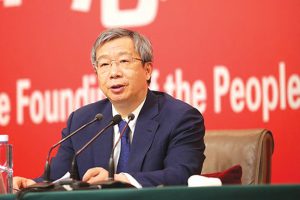Bloomberg
China’s central bank governor stressed the importance of keeping inflation under control in two separate speeches and pledged more targeted support for small businesses, reinforcing policy makers’ cautious approach to monetary stimulus.
The People’s Bank of China’s “policy is to maintain price stability,†Governor Yi Gang said on a panel at the Boao Forum for Asia. In separate comments delivered at a meeting of the International Monetary and Financial Committee, he emphasised that “China’s monetary policy’s primary
objectives are stable prices and
stable employment.â€
Monetary policy is in a “comfortable range†and is helping to support the economy, the governor said at the Boao forum, refraining from mentioning more broader steps it could take, like cutting interest rates or giving banks a cash boost. Instead, he highlighted the structural policies the PBOC has introduced to boost weaker sectors in the economy, such as small businesses.
The comments reflect the PBOC’s moderate approach to monetary easing despite calls for stronger action to cushion the economy against worsening Covid outbreaks and stringent lockdowns to control infections. Investors have been disappointed by Beijing’s lack of stimulus so far, with stock markets tumbling in recent weeks.
The PBOC refrained from cutting policy interest rates last week and lowered the reserve requirement ratio for banks by a smaller-than-expected margin. Yi stressed that monetary policy is working in tandem with fiscal policy to boost the economy.
The Federal Reserve’s rate hikes are adding another complication, restricting the PBOC’s policy room as foreign investors begin to pull funds out of Chinese assets, putting pressure on the yuan.
Yi stressed that monetary policy is working in tandem with fiscal policy to boost the economy. Referring to the PBOC’s planned transfer of 1 trillion yuan ($155 billion) of profit to the central government, he said the funds will mainly be used for value-added tax refunds and budget transfers to local governments.
“This is a good example of a combination of an accommodative monetary policy and proactive fiscal policy,†he said.
 The Gulf Time Newspaper One of the finest business newspapers in the UAE brought to you by our professional writers and editors.
The Gulf Time Newspaper One of the finest business newspapers in the UAE brought to you by our professional writers and editors.
